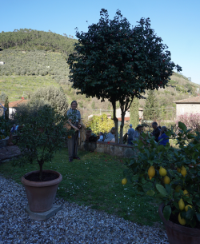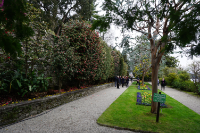Camellias are special plants that bloom from September thru April, they bring color and joy into any garden after the summer blooms have vanished and the Fall colors start to fade. They can be used as a specimen plant to accent an area or, because of their large, glossy leaves, can be used as a privacy hedge
or, because of their large, glossy leaves, can be used as a privacy hedge . There is nothing more beautiful than a bowl of floating Camellia blooms or arrangement to grace your home
. There is nothing more beautiful than a bowl of floating Camellia blooms or arrangement to grace your home
There are over 200 species of Camellia, some of the most recognizable are Japonica, Sasanqua, Reticulata, and Sinensis, with over 6000 varieties. Blooms range in size from ½ inch in diameter up to the showy dinner plate size of the species Reticulata
 Bloom color ranges from pure white to deep maroon. Blooms can also display variegation where a mixture and dark and light colors blend together in a marbled or moiré pattern.
Bloom color ranges from pure white to deep maroon. Blooms can also display variegation where a mixture and dark and light colors blend together in a marbled or moiré pattern.

These are the seven forms of the flower, from a simple single layer with up to 8 petals in the Single to the to the peony forms and highly geometric Formal Double. Some varieties will span multiple forms.

Camellias grow in Zones 8-10. USDA Plant Hardiness Map Therefore, it is best to be selective for cold hardiness as to the varieties grown depending on your particular area. The good news is that breeders are producing more cold hardy plants. Learn more about Cold Hardy Camellias Here: ACS Cold Hardy Camellias by G. Phillips
Well established plants can survive hard freezes; however, bloom buds do suffer. The plants like dappled shade and well-drained soil. Since Camellias are shallow rooted plants, it is best to apply a mulch. Camellias are very sturdy and suffer few problems from disease and pests. All can be easily treated with organic materials.
For More Information on Camellia Culture click Here
